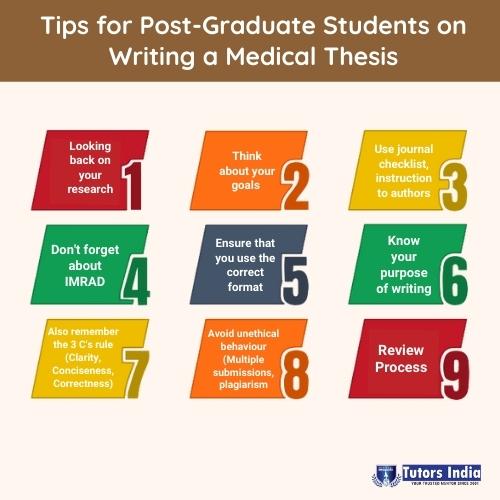Writing a Medical Thesis: Tips for Postgraduate Students
In brief
A medical thesis is a type of literature that is the outcome of original research in the fields of medicine, nursing, pharmacy, and other health and life sciences. Students submit it in order to get a higher degree from the university. But keep this in mind! The goal of submitting a medical thesis writing is not just to obtain a PhD or postgraduate degree, but instead, it is a medium for organizing scientific information to advance in the field.
Introduction
The primary goal of a medical thesis is to identify particular processes and reasons that contribute to the development of different disorders. For example, one purpose of undertaking a medical thesis may be to learn how people’s bodies operate, why specific illnesses or diseases occur, how they might be prevented, and how to preserve general well-being. The original objective of a medical thesis is often to enhance one’s health. For example, in a medical thesis, a student’s perspective of a student frequently deals with extending understanding of a specific medical issue. As a result, when a student does a thesis on Tuberculosis, they will examine the issue thoroughly and assess it from many angles. Finally, the learner will understand the condition, when it emerges, and how to prevent it and treat it effectively.
Writing your medical thesis
After choosing a topic for your research study, work with your supervisor to construct it and its objectives. Before beginning your clinical trials, gather all the information and data related to the steps in writing your research paper. You now have your study data and clinical findings ready. You only need to document your results in your medical thesis (Aaron, et al 2013) (1).

- Outline the structure of the medical thesis
Prepare a thesis outline in accordance with the following sections:
- Title
- Introduction: Why did you begin your research?
- Study Methods
- Study Results
- Discussion of Study Results
- Conclusion
In each, list the important parts and chapters. Work on one part at a time. Then, assemble all of the figures and tables and arrange them in a logical order.
2. Writing a title of the thesis
Your thesis’s title reflects its substance. For creating an ideal thesis title, consider the following:
- Be succinct and precise. The title should not be too long or too short.
- Avoid using extraneous words and phrases such as “Observation of” or “A study of.”
- Avoid using abbreviations.
- Avoid grammatical errors
3. Writing an Introduction
The goal of a medical manuscript writing Introduction is to give the reader appropriate background knowledge on the topic and to assist him in understanding and evaluating the results of the current study without the need to refer to earlier publications on the topic.
- Provide a summary of this background information in the opening paragraph.
- Please include in the second paragraph the significance of the situation and what is unknown.
- In the final paragraph, state your investigation’s goal, hypothesis, and objective.
Do’s
Cite the research articles that have been authored on your study topic.
Don’ts
- Include extraneous material other than the topic under consideration;
- Include the research strategy, data, or conclusion of your study;
- Cite well-known facts; and
- Include information found in any subject textbook.
- Writing the section on “Methods Used.”
This part must be written in such a way that the reader may repeat the investigation and confirm its findings.
- Provide references but no description for known procedures; provide a complete exposition regarding the participants in the study, what materials you employed, and how you analyzed the data.
- Provide a summary and sources for procedures that have been published but are less well-known.
- Please provide a full description of new procedures, including the rationale for employing them and any restrictions that may exist.
Don’ts
- Include background information and research findings;
- Refer to animals and patients as material;
- Do not use medication trade names; instead, use generic names; and
- Use non-technical language for technical statistical jargon.
- Writing your Results
While writing the “Results” section, keep the goal of your study in mind. The research findings can be documented as follows:
- Text
- Tables
- Figures
- Illustrative graphs
Text may be used to summarize small pieces of information. Use tables, figures, and graphs sparingly in your paper. Furthermore, do not duplicate information from the table or figure in the text format. The text must provide a summary or highlight of the data in the tables or figures.
6. Discussing your Results
An excellent medical thesis has a focused discussion that stays on the research theme. Include a statement of the main results. Make it apparent that your thesis contains new information.
Your study’s strengths and shortcomings
- Your study’s strengths and weaknesses in comparison to other studies
- A key message from your research for doctors and policymakers
- Any unsolved questions in your study to recommend new research
How to conclude your medical thesis?
The conclusion of your research study must comprise of:
- The most important statement or remark from the observations
- Summary of new observations, interpretations, and insights from the present study
- How your study fills the knowledge gap in its respected field?
- The broader implications of your work
- How can future research improve your work?
Conclusion
That is why experts in medical thesis writing emphasize the significance of selecting the correct topic for your thesis. Through your medical thesis, you must be able to solve a true problem or group of problems. Choose a topic that interests you and where you may add a new viewpoint through your research study (Greenfield et al 2016)(2).
About Tutors India
We also help you produce a whole medical dissertation, from the introduction to the recommendations, including time management. Tutors India’s US and UK writers aim to instil knowledge in students and instill confidence in them so that they can successfully submit their research work, such as Public Health Policy Analysis, a case study of an organization, the study of a specific intervention or event, secondary data analysis, meta-analysis, systematic review, reflection based dissertation, and so on.
References
- Lawson McLean, Aaron, et al. “Twelve tips for teachers to encourage student engagement in academic medicine.” Medical Teacher 35.7 (2013): 549-554.
- Greenfield, Tony, and Sue Greener, eds. Research methods for postgraduates. John Wiley & Sons, 2016.

 Previous Post
Previous Post Next Post
Next Post